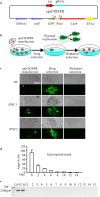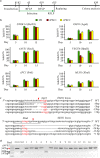An episomal vector-based CRISPR/Cas9 system for highly efficient gene knockout in human pluripotent stem cells
- PMID: 28539611
- PMCID: PMC5443789
- DOI: 10.1038/s41598-017-02456-y
An episomal vector-based CRISPR/Cas9 system for highly efficient gene knockout in human pluripotent stem cells
Erratum in
-
Author Correction: An episomal vector-based CRISPR/Cas9 system for highly efficient gene knockout in human pluripotent stem cells.Sci Rep. 2018 Dec 12;8(1):17900. doi: 10.1038/s41598-018-36738-w. Sci Rep. 2018. PMID: 30538257 Free PMC article.
Abstract
Human pluripotent stem cells (hPSCs) represent a unique opportunity for understanding the molecular mechanisms underlying complex traits and diseases. CRISPR/Cas9 is a powerful tool to introduce genetic mutations into the hPSCs for loss-of-function studies. Here, we developed an episomal vector-based CRISPR/Cas9 system, which we called epiCRISPR, for highly efficient gene knockout in hPSCs. The epiCRISPR system enables generation of up to 100% Insertion/Deletion (indel) rates. In addition, the epiCRISPR system enables efficient double-gene knockout and genomic deletion. To minimize off-target cleavage, we combined the episomal vector technology with double-nicking strategy and recent developed high fidelity Cas9. Thus the epiCRISPR system offers a highly efficient platform for genetic analysis in hPSCs.
Conflict of interest statement
The authors declare that they have no competing interests.
Figures






Similar articles
-
A Scaled Framework for CRISPR Editing of Human Pluripotent Stem Cells to Study Psychiatric Disease.Stem Cell Reports. 2017 Oct 10;9(4):1315-1327. doi: 10.1016/j.stemcr.2017.09.006. Stem Cell Reports. 2017. PMID: 29020615 Free PMC article.
-
Single-step generation of gene knockout-rescue system in pluripotent stem cells by promoter insertion with CRISPR/Cas9.Biochem Biophys Res Commun. 2014 Feb 7;444(2):158-63. doi: 10.1016/j.bbrc.2014.01.037. Epub 2014 Jan 22. Biochem Biophys Res Commun. 2014. PMID: 24462858
-
Development of a baculoviral CRISPR/Cas9 vector system for beta-2-microglobulin knockout in human pluripotent stem cells.Mol Genet Genomics. 2024 Aug 1;299(1):74. doi: 10.1007/s00438-024-02167-w. Mol Genet Genomics. 2024. PMID: 39085666
-
Production of genome-edited pluripotent stem cells and mice by CRISPR/Cas.Endocr J. 2016;63(3):213-9. doi: 10.1507/endocrj.EJ15-0734. Epub 2016 Jan 6. Endocr J. 2016. PMID: 26743444 Review.
-
CRISPR/Cas9 genome editing in human pluripotent stem cells: Harnessing human genetics in a dish.Dev Dyn. 2016 Jul;245(7):788-806. doi: 10.1002/dvdy.24414. Epub 2016 Jun 9. Dev Dyn. 2016. PMID: 27145095 Review.
Cited by
-
Structural Basis of Human Helicase DDX21 in RNA Binding, Unwinding, and Antiviral Signal Activation.Adv Sci (Weinh). 2020 Jun 8;7(14):2000532. doi: 10.1002/advs.202000532. eCollection 2020 Jul. Adv Sci (Weinh). 2020. PMID: 32714761 Free PMC article.
-
The Interaction of Influenza A NS1 and Cellular TRBP Protein Modulates the Function of RNA Interference Machinery.Front Microbiol. 2022 Apr 26;13:859420. doi: 10.3389/fmicb.2022.859420. eCollection 2022. Front Microbiol. 2022. PMID: 35558132 Free PMC article.
-
Gene delivery methods and genome editing of human pluripotent stem cells.Rep Pract Oncol Radiother. 2019 Mar-Apr;24(2):180-187. doi: 10.1016/j.rpor.2019.01.007. Epub 2019 Feb 18. Rep Pract Oncol Radiother. 2019. PMID: 30820192 Free PMC article. Review.
-
Single-cell RNA sequencing reveals that BMPR2 mutation regulates right ventricular function via ID genes.Eur Respir J. 2022 Jul 7;60(1):2100327. doi: 10.1183/13993003.00327-2021. Print 2022 Jul. Eur Respir J. 2022. PMID: 34857612 Free PMC article.
-
MST1R Gene Variants Predispose Individuals to Tetralogy of Fallot.Phenomics. 2025 Jan 21;4(6):548-561. doi: 10.1007/s43657-024-00175-9. eCollection 2024 Dec. Phenomics. 2025. PMID: 40061823 Free PMC article.
References
Publication types
MeSH terms
LinkOut - more resources
Full Text Sources
Other Literature Sources
Research Materials

